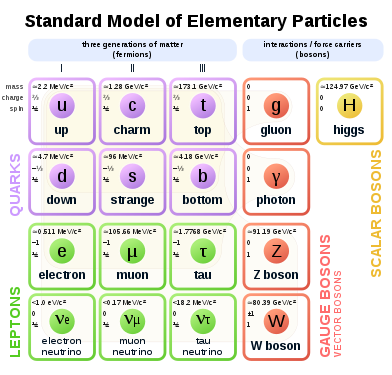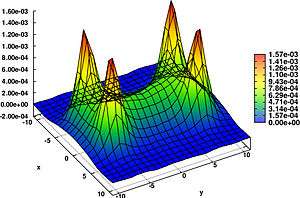Tetraquark
A tetraquark, in particle physics, is an exotic meson composed of four valence quarks. A tetraquark state has long been suspected to be allowed by quantum chromodynamics,[1] the modern theory of strong interactions. A tetraquark state is an example of an exotic hadron which lies outside the conventional quark model classification.
| Standard Model of particle physics |
|---|
 |
|
Scientists Rutherford · Thomson · Chadwick · Bose · Sudarshan · Koshiba · Davis Jr. · Anderson · Fermi · Dirac · Feynman · Rubbia · Gell-Mann · Kendall · Taylor · Friedman · Powell · P. W. Anderson · Glashow · Iliopoulos · Maiani · Meer · Cowan · Nambu · Chamberlain · Cabibbo · Schwartz · Perl · Majorana · Weinberg · Lee · Ward · Salam · Kobayashi · Maskawa · Yang · Yukawa · 't Hooft · Veltman · Gross · Politzer · Wilczek · Cronin · Fitch · Vleck · Higgs · Englert · Brout · Hagen · Guralnik · Kibble · Ting · Richter |
History and Discoveries
Several tetraquark candidates have been reported by particle physics experiments in the 21st century. The quark contents of these states are almost all qqQQ, where q represents a light (up, down or strange) quark, Q represents a heavy (charm or bottom) quark, and antiquarks are denoted with an overline. The existence and stability of tetraquark states with the qqQQ (or qqQQ) have been discussed by theoretical physicists for a long time, however these are yet to be reported by experiments.[2]

In 2003 a particle temporarily called X(3872), by the Belle experiment in Japan, was proposed to be a tetraquark candidate,[4] as originally theorized.[5] The name X is a temporary name, indicating that there are still some questions about its properties to be tested. The number following is the mass of the particle in MeV/c2.
In 2004, the DsJ(2632) state seen in Fermilab's SELEX was suggested as a possible tetraquark candidate.[6]
In 2007, Belle announced the observation of the Z(4430) state, a
c
c
d
u
tetraquark candidate. There are also indications that the Y(4660), also discovered by Belle in 2007, could be a tetraquark state.[7]
In 2009, Fermilab announced that they have discovered a particle temporarily called Y(4140), which may also be a tetraquark.[8]
In 2010, two physicists from DESY and a physicist from Quaid-i-Azam University re-analyzed former experimental data and announced that, in connection with the
ϒ
(5S) meson (a form of bottomonium), a well-defined tetraquark resonance exists.[9][10]
In June 2013, the BES III experiment in China and the Belle experiment in Japan independently reported on Zc(3900), the first confirmed four-quark state.[11]
In 2014, the Large Hadron Collider experiment LHCb confirmed the existence of the Z(4430) state with a significance of over 13.9 σ.[12][13]
In February 2016, the DØ experiment reported evidence of a narrow tetraquark candidate, named X(5568), decaying to
B0
s
π±
.[14]
In December 2017, DØ also reported observing the X(5568) using a different
B0
s final state.[15]
However, it was not observed in searches by the LHCb,[16] CMS,[17] CDF,[18] or ATLAS[19] experiments.
In June 2016, LHCb announced the discovery of three additional tetraquark candidates, called X(4274), X(4500) and X(4700).[20][21][22]
In 2020, LHCb announced the discovery of a
c
c
c
c
tetraquark: X(6900).[23][24]
See also
References
- U. Kulshreshtha; D. S. Kulshreshtha; J. P. Vary (2015). "Hamiltonian, path integral and BRST formulations of large N scalar QCD2 on the light-front and spontaneous symmetry breaking". European Physical Journal C. 75 (4): 174. arXiv:1503.06177. Bibcode:2015EPJC...75..174K. doi:10.1140/epjc/s10052-015-3377-x.
- Si-Qiang, Luo; Kan, Chen; Xiang, Liu; Yan-Rui, Liu; Shi-Lin, Zhu (25 October 2017). "Exotic tetraquark states with the qqQQ configuration" (PDF). European Physical Journal C. 77:709 (10). doi:10.1140/epjc/s10052-017-5297-4. Retrieved 26 November 2017.
- N. Cardoso; M. Cardoso; P. Bicudo (2011). "Colour Fields Computed in SU(3) Lattice QCD for the Static Tetraquark System". Physical Review D. 84 (5): 054508. arXiv:1107.1355. Bibcode:2011PhRvD..84e4508C. doi:10.1103/PhysRevD.84.054508.
- D. Harris (13 April 2008). "The charming case of X(3872)". Symmetry Magazine. Retrieved 2009-12-17.
- L. Maiani; F. Piccinini; V. Riquer; A.D. Polosa (2005). "Diquark-antidiquarks with hidden or open charm and the nature of X(3872)". Physical Review D. 71 (1): 014028. arXiv:hep-ph/0412098. Bibcode:2005PhRvD..71a4028M. doi:10.1103/PhysRevD.71.014028.
- Kulshreshtha, Usha; Daya Shankar Kulshreshtha; Vary, James P. (2005). "Regge Trajectories Analysis to D⋆
SJ(2317)±, DSJ(2460)± and DSJ(2632)+ Mesons". Physical Review D. 72: 017902. arXiv:hep-ph/0408124. doi:10.1103/PhysRevD.72.017902. - G. Cotugno; R. Faccini; A.D. Polosa; C. Sabelli (2010). "Charmed Baryonium". Physical Review Letters. 104 (13): 132005. arXiv:0911.2178. Bibcode:2010PhRvL.104m2005C. doi:10.1103/PhysRevLett.104.132005. PMID 20481876.
- A. Minard (18 March 2009). "New Particle Throws Monkeywrench in Particle Physics". Universe Today. Retrieved 2014-04-12.
- Z. Matthews (27 April 2010). "Evidence grows for tetraquarks". Physics World. Retrieved 2014-04-12.
- A. Ali; C. Hambrock; M.J. Aslam (2010). "Tetraquark Interpretation of the BELLE Data on the Anomalous Υ(1S)π+π− and Υ(2S)π+π− Production near the Υ(5S) Resonance". Physical Review Letters. 104 (16): 162001. arXiv:0912.5016. Bibcode:2010PhRvL.104p2001A. doi:10.1103/PhysRevLett.104.162001. PMID 20482041.
- E. Swanson (2013). "Viewpoint: New Particle Hints at Four-Quark Matter". Physics. 6: 69. Bibcode:2013PhyOJ...6...69S. doi:10.1103/Physics.6.69.
- C. O'Luanaigh (9 Apr 2014). "LHCb confirms existence of exotic hadrons". CERN. Retrieved 2016-04-04.
- R. Aaij; et al. (LHCb collaboration) (2014). "Observation of the resonant character of the Z(4430)− state". Physical Review Letters. 112 (22): 222002. arXiv:1404.1903. Bibcode:2014PhRvL.112v2002A. doi:10.1103/PhysRevLett.112.222002. PMID 24949760.
-
V. M. Abazov; et al. (D0 collaboration) (2016). "Observation of a new
B0
s
π±
state". Physical Review Letters. 117 (2): 022003. arXiv:1602.07588. Bibcode:2016PhRvL.117b2003A. doi:10.1103/PhysRevLett.117.022003. PMID 27447502. - Abazov, V.M.; et al. (D0 collaboration) (2018). "Study of the X±(5568) state with semileptonic decays of the B0
s meson". Physical Review D. 97 (9): 092004. arXiv:1712.10176. doi:10.1103/PhysRevD.97.092004. - J. van Tilburg (13 March 2016). "Recent hot results & semileptonic b hadron decay" (PDF). CERN. Retrieved 2016-04-04.
- Sirunyan, A. M.; et al. (CMS Collaboration) (2018). "Search for the X(5568) State Decaying into B0
sπ± in Proton-Proton Collisions at √s =8 TeV". Physical Review Letters. 120 (20): 202005. arXiv:1712.06144. doi:10.1103/PhysRevLett.120.202005. PMID 29864318. - Aaltonen, T.; et al. (CDF Collaboration) (2018). "A search for the exotic meson X(5568) with the Collider Detector at Fermilab". Physical Review Letters. 120 (20): 202006. arXiv:1712.09620. doi:10.1103/PhysRevLett.120.202006. PMID 29864341.
- Aaboud, M.; et al. (ATLAS Collaboration) (2018). "Search for a Structure in the B0
s π± Invariant Mass Spectrum with the ATLAS Experiment". Physical Review Letters. 120 (20): 202007. arXiv:1802.01840. doi:10.1103/PhysRevLett.120.202007. PMID 29864314. - Announcement by LHCb
- R. Aaij; et al. (LHCb collaboration) (2017). "Observation of J/ψφ structures consistent with exotic states from amplitude analysis of B+→J/ψφK+ decays". Physical Review Letters. 118 (2): 022003. arXiv:1606.07895. Bibcode:2017PhRvL.118b2003A. doi:10.1103/PhysRevLett.118.022003. PMID 28128595.
- R. Aaij; et al. (LHCb collaboration) (2017). "Amplitude analysis of B+→J/ψφK+ decays". Physical Review D. 95 (1): 012002. arXiv:1606.07898. Bibcode:2017PhRvD..95a2002A. doi:10.1103/PhysRevD.95.012002.
- R. Aaij; et al. (LHCb collaboration) (2020). "Observation of structure in the J/ψ-pair mass spectrum". arXiv:2006.16957.
- "Observation of a four-charm-quark tetraquark". LHCb - Large Hadron Collider beauty experiment. CERN. 1 July 2020. Retrieved 12 July 2020.
External links
- The Belle experiment (press release)
- O'Luanaigh, Cian. "LHCb confirms existence of exotic hadrons". cern.ch. Geneva, Switzerland: CERN. Retrieved 2014-04-12.